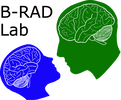What is EEG?
EEG stands for "electroencephalography". It uses a wet net to measures electrical activity. Because your brain sends out electrical signals when you think, we can record your brain waves as you watch movies, listen to sounds, and interact with other people!
What are brain waves?Simply put, brain waves are electrical impulses in the brain. When people think, feel, or act, neurons in the brain “fire” or send an electrical signal to neighboring neurons. They are called "brain waves” because this signal fluctuates -- going up and down, every millisecond! This can also be called an "neural (brain) oscillation" (rhythmic or repetitive patterns of brain activity) that capture how your brain communicates across brain regions.
|
|
Why is the EEG net wet?
At the B-RAD lab, the EEG nets will be soaked in a solution to help measure the brain waves before it's placed on a participant’s head. This type of EEG is referred to as wet-EEG. Wetting the net with an electrolytic (salt!) solution improves the the quality of the data we record. It may also be necessary to re-wet some of the electrodes as they dry out during the session.
How do you put on the net?
The EEG nets that we use go on the head in seconds -- this is great for babies and individuals that may have sensory issues! Our goal is to get each of the recording sites next to the skin on your head. Here are some videos showing what it is like to put the net on when you have braided hair:
|
|
|
|
